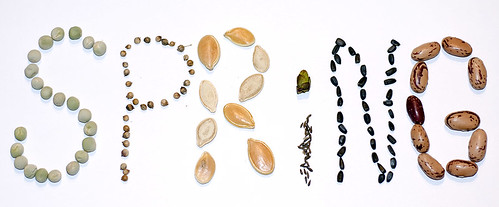Spring-ish Garden Update
Yes, I know, mid-June is hardly “spring” any more, especially in places outside of Colorado. Around here, we just turned off our furnaces a couple weekends ago, and the world is green and lush! I’m sure summer will be hitting us soon, any day now.
This spring, gardening got a bit of a sideline due to morning sickness, but it was the first activity I turned to when I could get off the couch. Mark has really chipped in more than his share as well, and we’ve managed to pull together a good looking set-up this year.
Subtle Changes
Another reason I managed to pull together a garden between bouts of yaking is that I have manged to build up a good infrastructure for containers, a raised bed, and watering in the last few years. Based on my experiences from last year, though, we made a few little changes.
First of all, we wanted a tomatillo, but didn’t want it crawling all over the lawn this year. I’ve stuck it in a container hoping that will help restrain its growth slightly. We had discussed putting a tomatillo in an up-side-down grower of some sort, but Mark felt that if the plant wasn’t anchored to the earth, it might get free and run around the neighborhood, making “RAWR” noises and wearing it’s little green topsy-turvey hat.
We moved the big mountain tomato to a container as well, as I didn’t like my tomatoes hanging into the basement window-well last year. This left plenty of space for our pepper plants in the raised bed. They fit very nicely, but haven’t seemed perfectly happy this year. They got some hail damage over Memorial Day, and may be wanting more sun than that east-bed gets.
Little Successes
One of my proudest moments as a container gardener came last week when we decided to crack open the compost bin. I’ve had this homemade compost bin behind the garage for two years now. We made it out of a small black trash can, covered in holes and lined with window screens. I’ve spent two years filling it with leftover veggies from the CSA, egg shells, coffee grounds and other random greenness. And finally, it has all paid off. Under a layer of dry leaves, sat some of the prettiest, lovely dark compost I could have hoped for. I grew dirt! WOW!
We pulled about a cubic meter of the lovely dark organic matter out of there, and used it to fill in a new tomato container. Those two years of composting have now officially saved us $5 in bought soil!
If everything works out, we should be looking at a big load of crops this year. Tomatoes, peppers, cucumbers, strawberries, pumpkins, sugar and snow peas, bush and pole beans, lettuce, carrots, onions, cilantro, basil, and lavender!



























